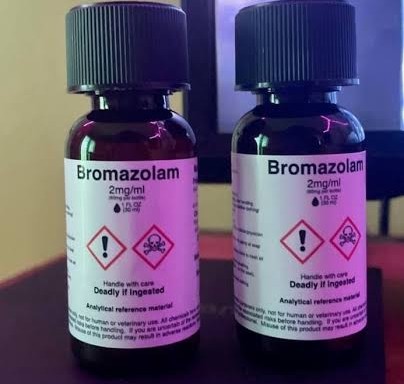Is Bromazolam a controlled substance?

What is Bromazolam?
Bromazolam, a chemical compound belonging to the benzodiazepine class, has gained attention in recent years for its potential therapeutic applications and recreational use. As with many substances, questions regarding its legal status and classification as a controlled substance have arisen.
Bromazolam is a derivative of benzodiazepine, a class of psychoactive drugs known for their sedative, hypnotic, anxiolytic, and muscle relaxant properties. Developed in the 1970s, benzodiazepines have been widely prescribed for various medical conditions, including anxiety disorders, insomnia, and seizures.
Bromazolam, specifically, has a unique chemical structure that distinguishes it from other benzodiazepines. Its pharmacological effects result from its ability to enhance the activity of gamma-aminobutyric acid (GABA), a neurotransmitter that inhibits brain activity. This heightened GABAergic activity leads to a calming effect on the central nervous system, producing the characteristic sedation associated with benzodiazepines.
Medical Uses and Potential Benefits
While bromazolam has not been approved for medical use in many countries, researchers have explored its potential therapeutic applications. Some studies suggest that it may be effective in treating conditions such as anxiety disorders, panic attacks, and insomnia. However, due to its potent sedative properties and the risk of dependence, further research is needed to establish its safety and efficacy compared to existing medications.
Recreational Use and Concerns
Despite its potential therapeutic uses, bromazolam has also found its way into the recreational drug scene. Individuals seeking relaxation or euphoria may misuse the substance, often obtaining it through illicit means. The recreational use of bromazolam is concerning due to its potential for abuse, dependence, and adverse effects, including impaired cognitive function and respiratory depression.
Is Bromazolam a controlled substance?
As a designer benzodiazepine, the legal status of bromazolam varies across different jurisdictions. In many countries, benzodiazepines are classified as prescription medications due to their potential for abuse and dependence. However, the specific classification of bromazolam can differ, and in some cases, it may be explicitly listed as a controlled substance.
In the United States, for example, the Drug Enforcement Administration (DEA) schedules controlled substances into different categories based on their potential for abuse and accepted medical use. Substances in Schedule I are considered to have a high potential for abuse and no accepted medical use, while those in Schedule V have a lower potential for abuse. However, bromazepam is not listed as a scheduled substance in the Controlled Substances Act (CSA) in the United States.
However, research chemicals like bromazolam are often categorized as synthetic drugs. This category encompasses a diverse range of substances, including well-known drugs like MDMA (ecstasy), ketamine, synthetic cathinones (commonly known as bath salts), and synthetic cannabinoids (such as Spice and K2). Referred to by many agencies as New psychoactive substances (NPS), these compounds are exclusively manufactured in laboratory settings, and their formulations often include legal analogs created with the explicit intention of circumventing drug enforcement laws. Frequently, the packaging of these products bears the cautionary label: “not for human consumption.”
The legal landscape surrounding research chemicals is complex, particularly in the United States, where both state and federal drug laws focus on outlawing specific molecules or chemical structures. However, research chemical manufacturers employ a shrewd strategy to elude these regulations by altering the drug’s structure whenever new laws are enacted. This adaptive approach not only makes research chemicals challenging to regulate but also renders them highly unpredictable and potentially dangerous. It’s important to note that the effects of these substances can vary widely, even within different batches of the same chemical. For instance, a particular batch may induce a stimulant-like high, while the subsequent batch might produce entirely different effects.
The United Nations Office on Drugs and Crime highlighted the global prevalence of new psychoactive substances in 2018, shedding light on the fact that most reported NPS were either combinations of previously identified substances or slightly modified versions of known chemicals. This constant cycle of modification and innovation has led to a staggering diversity in the NPS market. About 500 distinct NPS have been identified as being available on the drug market. This extensive variety poses a significant challenge for authorities attempting to regulate and control these substances effectively.
Regulatory Challenges
The regulation of novel psychoactive substances, including bromazolam, poses a significant challenge for authorities. As chemical structures can be modified to create new analogs with similar effects, regulatory bodies struggle to keep pace with the rapidly evolving landscape of designer drugs. Once a specific substance is classified as illegal or controlled, clandestine laboratories may alter its chemical structure slightly, creating a new compound with potentially different legal implications.
This cat-and-mouse game between regulators and clandestine chemists underscores the need for a flexible and adaptable regulatory framework. Policymakers must be proactive in identifying emerging substances, understanding their pharmacology, and assessing their potential risks to public health.
Public Health Concerns
The recreational use of bromazolam raises concerns about its impact on public health. Benzodiazepines, in general, can be highly addictive, and their misuse can lead to physical and psychological dependence. Overdose is a significant risk, particularly when combined with other central nervous system depressants such as alcohol or opioids. A Canadian study revealed low levels of bromazolam in post-mortem blood samples, suggesting its likely role in potentiating opioid effects rather than being utilized as a standalone drug. The presence of Bromazolam was consistently identified alongside opioids such as fentanyl and carfentanil, as well as stimulants like methamphetamine, and other benzodiazepines including etizolam and flualprazolam. This finding implies a potential synergistic interaction between Bromazolam and these substances, emphasizing the importance of considering polydrug use and its implications in forensic investigations.
In addition, the availability of these substances through online markets and underground channels makes it challenging for authorities to monitor and control their distribution. Public health campaigns and educational initiatives are essential to inform the public about the risks associated with the misuse of benzodiazepines and other psychoactive substances.
Harm Reduction Strategies
In addressing the challenges posed by the recreational use of bromazolam, harm reduction strategies play a crucial role. These strategies focus on minimizing the negative consequences of drug use without necessarily promoting abstinence. Education and awareness campaigns can provide individuals with information on the potential risks and harm associated with bromazolam use.
Healthcare professionals also play a vital role in harm reduction by providing support and treatment for individuals struggling with substance use disorders. Access to mental health services and addiction treatment programs is essential for those who may be experiencing negative effects from their use of bromazolam or other benzodiazepines.
Conclusion
Bromazolam, a benzodiazepine derivative, presents a complex picture with potential therapeutic benefits and associated risks, both in the medical and recreational contexts. Its legal status varies globally, with some jurisdictions explicitly listing it as a controlled substance and others addressing it within broader regulatory frameworks.
As the landscape of psychoactive substances continues to evolve, policymakers and regulatory bodies face ongoing challenges in keeping pace with the development of new compounds. Public health initiatives, harm reduction strategies, and comprehensive drug education are essential components of addressing the potential risks associated with bromazolam use.
Ultimately, a balanced and evidence-based approach is necessary to navigate the complex interplay between the pharmacological properties of substances like bromazolam, their legal status, and their impact on public health.





